Microplastics – “A Poison Like No Other”
Air Date: Week of March 31, 2023
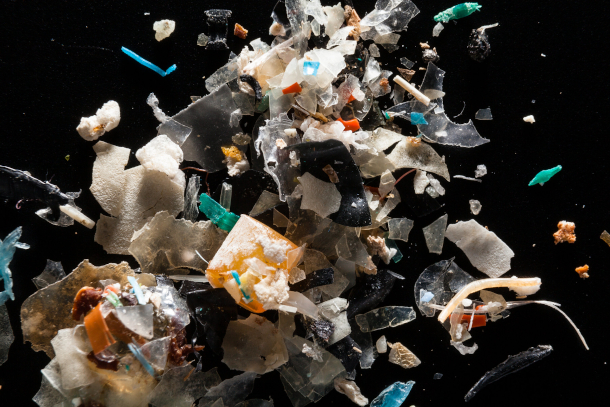
Microplastics from the Chesapeake Bay watershed are pictured in a laboratory. (Photo: Chesapeake Bay Program, Flickr CC BY-NC 2.0)
Microplastics are everywhere scientists have looked for them, from the deepest ocean trenches to mountain peaks. Micro and nano plastics are in our air, water, food, and our own bodies. The recent book “A Poison Like No Other: How Microplastics Corrupted Our Planet and Our Bodies” takes a deep dive into the world of these tiny pollutants laden with thousands of different chemicals. Author Matt Simon joins Host Bobby Bascomb to discuss the dangers and options to address the problem.
Transcript
CURWOOD: It’s Living on Earth, I’m Steve Curwood.
BASCOMB: And I’m Bobby Bascomb.
Plastic is ubiquitous in modern life, plastic bags, plastic furniture, plastic playgrounds. Even most of our clothes are now made of plastic fibers. But a lot of the plastic surrounding us is so small you probably don’t see it. Microplastics are literally everywhere scientists have looked for them: from the deepest ocean trenches to mountain peaks, in our air, water and food, even in our own bodies. And most plastic is made from a cocktail of thousands of chemicals which can cause unknown harms to both our health and the health of the ecosystems they contaminate. In the recent book “A Poison Like No Other: How Microplastics Corrupted Our Planet and Our Bodies” science journalist Matt Simon takes a deep dive into the world of microplastics and what we can do to stop them. Matt Simon, welcome to Living on Earth!
SIMON: And thank you for having me.
BASCOMB: So why do you consider microplastics "A Poison Like No Other," as is the title of your book?
SIMON: I mean that I think in two forms. So by one kind of metaphorical sense of poison, I'm talking about this material that has corrupted essentially every corner of the environment. It is in the air, it is in the land, it's in the sea; absolutely everywhere, so a widespread kind of material in that poisonous sort of sense. But I also mean poison in the classical toxicological sense, that this is a very complicated material, and a very toxic material, that has at least 10,000 different chemicals in it, a quarter of which scientists consider to be of concern, meaning it's either straight up toxic or persistent in the environment or in organisms. But plastic's this weird sort of poison and pollutant in that it's this physical thing in the environment. It is something that can get up in the atmosphere and change cloud formation; it is something that organisms that are small enough can swallow and choke on. In addition to that, as these particles are flying through the environment, floating through the environment, they are picking up this really complicated community of bacteria and viruses. So it's this, unlike a classical poison, like mercury, or lead, which is just an element, obviously neurotoxins, this is far more complicated. And scientists are just beginning to come to grips with it.
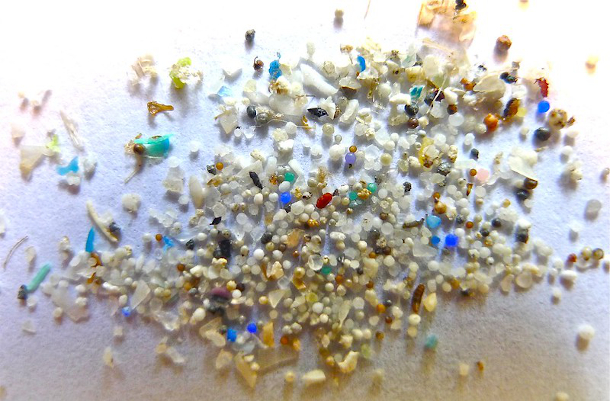
Microplastics contain and can leach the 10,000 or so different chemicals that plastics are made of. (Photo: 5Gyres, Oregon State University, Flickr CC BY-SA 2.0)
BASCOMB: You write in your book that there have been studies done showing that when people just walk through a room, they're literally bringing with them a wave of microplastics, you know, sort of depositing it in the air.
SIMON: I call it the "Pigpen effect" in the book, so Pigpen from the "Peanuts" comics: this perpetual, swirling aura of dirt and grime; we are doing the same thing with microfibers. So two thirds of clothing is now made out of plastic, I don't think very many people realize that. So polyester, nylon -- that's all plastic. It's very soft plastic, but it comes apart, both when it's being washed in a washing machine, but also, as you say, as we're walking through the environment. There was one calculation that we are shedding something like a billion of these fibers a year, just by walking around. And because we spend 90% of our time indoors, a good amount of that microplastic is settling on the floors of our homes. And scientists are finding that we are inhaling a lot of those particles every day. By one calculation, it's 7,000 particles that we inhale a day. And we know virtually nothing about the potential human health effects, other than to say that this is certainly not a good thing to have in the body.
BASCOMB: I mean, inhaling 7,000 a day; and, you know, the particles that we're talking about here are extremely small, hence the name microplastic. And you write in your book that any calculation that you can make is immediately outdated, because we're always creating more plastic, there's always going to be more microplastic introduced to the environment. But is there any way to quantify how many pieces of microplastic we're talking about here? Or, you know, give us a scale; or, I think the number is too big even to really understand. But can you compare it to anything that would you know, be real for our listeners?
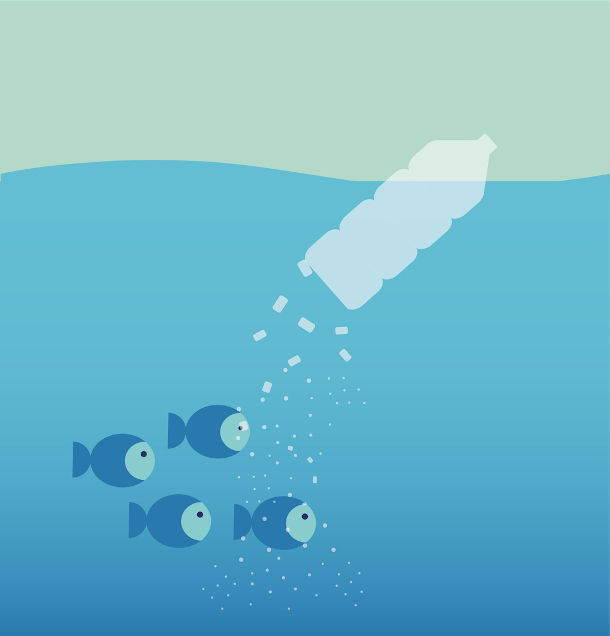
An illustration representing the breakdown of a plastic bottle in the ocean into smaller microplastics and nanoplastics that are then eaten by fish. “Think of those macro plastics, like bottles and bags, as pre-microplastic,” Matt Simon says. (Image: European Environmental Agency, Wikimedia Commons public domain)
SIMON: Yeah, so when we're talking about microplastics as defined by scientists, these are bits that are smaller than five millimeters. And that's about the width of a pencil eraser. So that's actually a microplastic you can see with your naked eye, and actually, if you look through a window in your home, and the sunlight is coming through it at sunset or sunrise, and you see little bits of things floating around, there's a good chance that a lot of those are actually plastic microfibers coming from bed sheets and clothing, carpeting, those sorts of things. But scientists are now getting better at detecting nanoplastics, and nanoplastics are far smaller. There's some debate over there what the threshold should be, but it's typically around a millionth of a meter. These nanoplastics are very, very tiny. And scientists are finding consistently -- it's still difficult and expensive to test for them, but when they do in the environment -- they're finding way, way more nanoplastics than microplastics. There was one study that looked at a remote mountaintop in the Alps, and detected for nanoplastics, these very, very tiny ones and found that if you were standing on the top of this mountain, just by standing there for a little while, you would have millions of these nanoplastics fall on your shoulders. That's outdoor air. So the atmosphere is thoroughly saturated with nanoplastics in numbers that are just difficult to comprehend. The frontier is, okay, well, when it comes to inhaling all those particles, how much is going to be too much to have in the human body? We don't want any of them. But when does it become a problem? And we'll see those studies probably in the next five or 10 years.
BASCOMB: Well, what do we know so far about the human health impacts of microplastics and micro fibers?

A graphic depicting surface microbial interactions with microplastics compared to zooplankton and phytoplankton (Image: Jake Bowley, Craig Baker-Austin, Adam Porter, Rachel Hartnell and Ceri Lewis, Wikimedia Commons CC BY-SA 4.0)
SIMON: So we are getting early studies on mouse models, in particular where you know you feed these mice microplastics or make them inhale the microplastics. And they're actually showing that these particles, especially the very small ones, can readily move through our tissues. Which is not surprising, because we are finding microplastics in human blood, and human lung tissue and guts, we are finding them in placentas, but also in the first feces of newborns, which means that these newborns are exposed to microplastics while they had been in their mothers, so these particles are crossing barriers. And it's not any surprise, because nanoplastics get down to a size where they're able to penetrate cells. And we have seen in a couple of studies that exposing human cells in the lab -- not exposing people, to be clear, you can't dose people with microplastics, just ethically -- but exposing cells themselves is highly, highly toxic.
BASCOMB: Well, you mentioned newborn babies with microplastics in their bodies, and you write in your book that babies and young children are particularly susceptible. Can you tell us more about that? Why are young children particularly of concern?
SIMON: The primary concern here is a group of chemicals known as endocrine disrupting chemicals, or EDCs. There are a bevy of these in plastics. The most famous one is BPA, which has been largely phased out because it was linked to any number of, of human health problems, cancers in particular. That is one of just many EDCs that we have in plastics. When we're considering these EDCs, they mess with the hormone system. And for children in particular, you do not want that. You especially do not want that, because we know that fetuses are exposed to microplastics in the womb, this is a very delicate time. It's this, I talk about it in the book as this kind of, this ballet, this intricate dance of so many of these hormones kicking off in sequence to build a healthy human being. But then, you know, when a kid is walking around the home, a toddler is toddling around on the floor, they are down to the level where so many of these fibers are settling. So EDCs, these are the groups of chemicals that scientists are mostly concerned about in plastics just because they are mucking with these very delicate hormone systems in the human body.
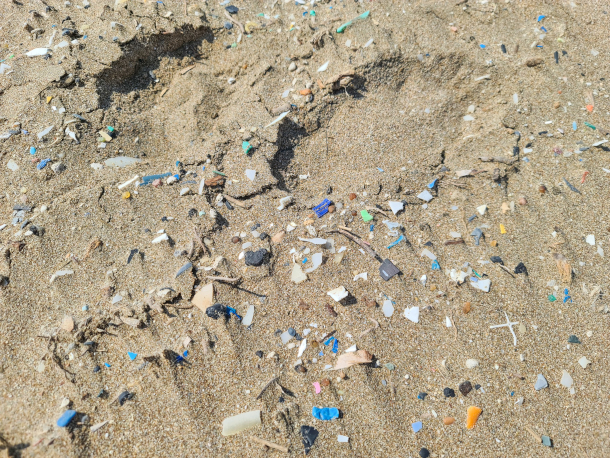
Microplastics on a beach (Photo: Vera Kratochvil, public domain CC0 license)
BASCOMB: And you write in your book, babies that are fed formula -- it has to be made with hot water, perhaps in a plastic bottle, and the action of shaking it, you know, is also releasing a lot of microplastic.
SIMON: This is a pretty scary study that came out a couple of years ago; perhaps not surprising, I think scientist knew for a long time that these are the forces that are best able to break apart plastic. If you are preparing hot liquid in plastic, and then shaking it up, you are providing exactly the sorts of things that do break apart plastics, which are these, of course, very tough chemicals, but they're not invincible. So these scientists showed that a baby might be ingesting a million of these particles a day. But coming back to this idea that they were looking for a certain size range of these plastics, they were not looking at nanoplastics. And it's likely much, much more nanoplastics, again, at this extremely delicate period of human development.
BASCOMB: So it's obviously very harmful to people and to the natural environment. You know, we've all seen images of sea turtles strangled by six pack rings, or seabirds with their stomachs full of plastic, and they're awful. But those are macro plastics, you know, large pieces of plastic that we can identify. But what about microplastics in the environment? Can you share a few examples of the kinds of impacts they're having on, you know, animals and ecosystems?
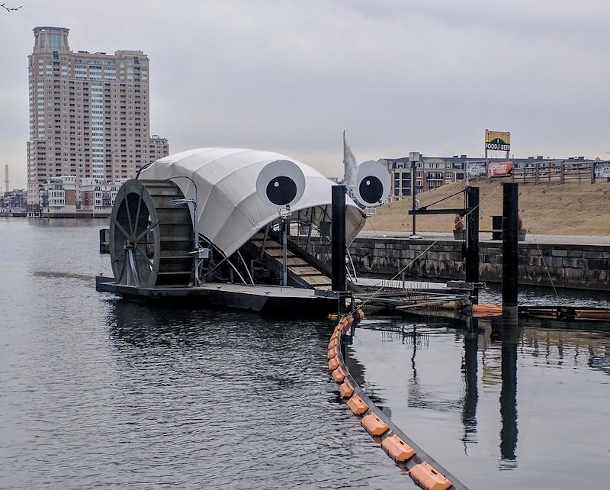
“Mr. Trash Wheel” is a floating garbage scooper that’s helping intercept plastics and other garbage in Baltimore, Maryland’s inner harbor. (Photo: Dicklyon, Wikimedia Commons, CC BY-SA 4.0)
SIMON: First of all, I think it's really important to think of those macro plastics, like bottles and bags, you know, a turtle choking on a plastic bag, that is essentially pre-microplastic, is I think a good way to think of it. Any of those plastic products are going to break down over time into microplastics and nanoplastics. So when they do eventually disintegrate, they haven't disappeared, they've just deconstructed into sort of this galaxy of particles that then float around the ocean. So macro plastics are not available to a tremendous amount of sea creatures, right? So like a whale or a dolphin or a turtle is able to choke on these things, but there are vastly more smaller creatures in the ocean that are able to choke on microplastics. So primarily, this is the planktonic community. So you have phytoplankton, which are little plant-like organisms that grow on the surface. Those are eaten by zooplankton, these little tiny animals. It's this very delicate food web where that then goes on to feed everything else. So fish larvae feed on those zooplankton, the larvae themselves become food for bigger fish, and on and on. Scientists have been finding that these zooplankton, little crustaceans and things like that, readily eat microplastics. These are just the right size to kind of jam into these tiny digestive systems. So there are two concerns here. One is that these creatures are filling up their stomachs with microplastics, and that decreases their appetite for actual food, so they starve to death. The other is that you have these plastics breaking apart further in their digestive systems and leaching out the component chemicals -- again, 10,000 of them, any one of which might be toxic to a particular organism.
BASCOMB: You know, the Earth is really good at cycling energy, you know, we think of ocean and atmospheric currents like the Gulf Stream or the jet stream, and you write here about how microplastics are really getting taken up in those currents to get transported literally everywhere scientists have looked for them. Can you tell us a bit about that, please?
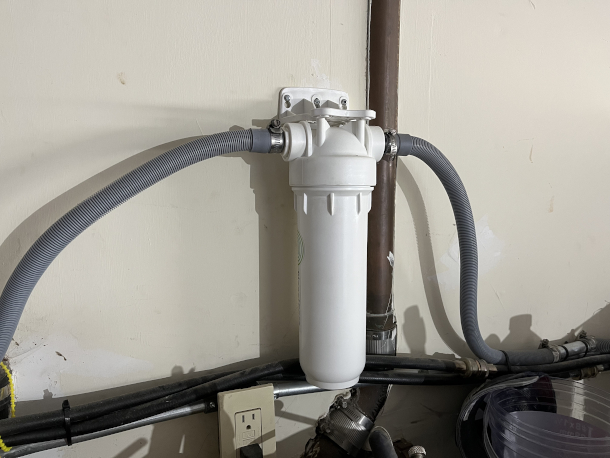
The after-market microplastic filter attached to author Matt Simon’s washing machine. (Photo: Matt Simon)
SIMON: In the ocean, it probably shouldn't come as any surprise, really, that we're finding these microplastics, you know, up and down the water column here in the ocean. They are finding extreme amounts of these plastics in the Mariana Trench, one of the deepest points in the ocean; it has gotten absolutely everywhere, because it is a fundamental part now of this carbon cycle. Creatures eat these, they poop them out, they sink, other creatures eat them, they sink, and it's gathering in these ocean sediments. And it's important here to not think of these as separate systems, right? So the ocean is not at all a separate entity from the atmosphere. And scientists are showing in fact that when bubbles come up in the ocean, they gather microplastics, and pop at the surface and actually fling those microplastics into the atmosphere. And that then blows onto land as a sea breeze. And that is part of the reason why the atmosphere is so thoroughly contaminated with microplastics, because it's basically burping out of the ocean. That then is flying around in, essentially, atmospheric currents, as it is in the ocean. They are so light, these microplastics, so tiny, they very readily get everywhere.
BASCOMB: So we know of course, that plastic is made from fossil fuels. And it's widely considered to be the the fossil fuel companies' Plan B, if we're going to move away from combustion engines and you know, fossil fuels for energy. Can you talk a bit about that, and the trajectory that we're on for creating more plastic going forward?
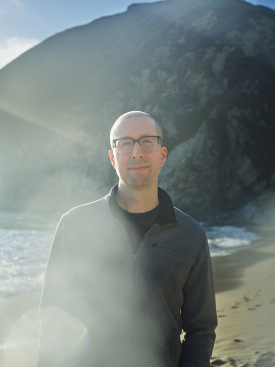
Matt Simon is a science journalist at Wired magazine, where he covers the environment, biology, and robotics. He’s the author of “A Poison Like No Other” and two other books. (Photo: Jenna Garrett)
SIMON: These companies have really made no secret about the writing on the wall, as they see it, and as we all see it: that we're going to decarbonize our economy at some point. We're going to move away more and more from fossil fuels into renewables. And what these companies -- these are the same companies, basically, these fossil fuel companies, petrochemical companies, it's all the same crew -- they are massively shifting their production into plastics, tripling production, perhaps by the year 2050, because that's their source of revenue going forward. All along the supply chain, we have issues with climate change and these plastics, and in these interesting ways, once they get out into the environment as well, there has been research showing that as microplastics degrade in the environment, they release methane in particular, which is a extremely potent greenhouse gas, something like 80 times more powerful a planet warmer than carbon dioxide. So now we have to consider, there is so much of this stuff in the atmosphere. How much of this it is actually off gassing? How much methane is it contributing to global levels? There's a calculation that if we have this exponential increase in the production of plastic by 2050, the emissions inherent in that will be equal to 600 coal fired power plants, which is a lot. It's a lot of carbon. And that's the injustice here, is that as we're actually making good progress as a species decarbonizing, switching to renewable energy, decommissioning coal plants in the United States and elsewhere, we're having the rise of this separate source of emissions in plastics. This is an emissions intensive industry, and as it grows exponentially, so too, will the emissions.
BASCOMB: How do we, you know, adequately think about really tackling this problem? I mean, it's ubiquitous, plastic is everywhere; it's all things, we all use it. I mean, where do you even begin to really address this issue?
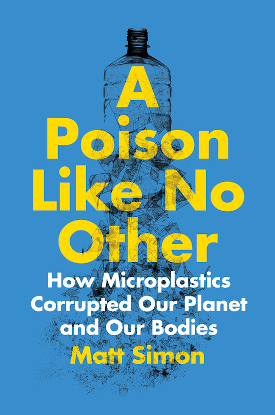
“A Poison Like No Other: How Microplastics Corrupted Our Planet and Our Bodies” (Image: Island Press)
SIMON: At the end of the day, the only way we're going to fix this problem is to just stop producing so much plastic. There is no substitute for that. You've probably heard of the ocean cleanup -- a giant plastic catcher in the Pacific Ocean -- rather silly, in my opinion, and the opinion of a lot of plastic scientists, that it's too late at that point. We need to stop these plastics from getting out there in the first place. So the farthest upstream we can go is stopping producing so much plastic. That is the only thing that's going to fix this; that is roundly agreed upon by plastics activists and plastic scientists. We can go a little bit farther downstream; a really fun and very useful piece of technology is called "Mr. Trash Wheel." It is a barge in Baltimore Harbor that has big googly eyes. It's absolutely adorable, but it's also very useful. It catches a lot of this plastic floating out to sea before it can get to sea. And then when it comes to mitigating something like the microfibers from our clothes, perhaps millions of these fibers break off in a single load of laundry and then flush out to a wastewater treatment facility. 10% of those fibers are flushed out to the ocean, where they of course go on to get into the stomachs of these zooplankton and other sea creatures, but 90% is sequestered in sludge, which is human waste applied as fertilizer to fields. So we're applying concentrated microplastics to our crops. So what we need, then, is filters on washing machines, right? Unfortunately, don't have those in the United States, we have filters on our dryers to catch the lint. But what you can get right now is an aftermarket filter for your washing machine. I have one at home, and it seems to work pretty well. I mean, it's fantastic that we do individual things. And I think that can add up into something actually very impactful if, you know, you tell your friends about microfiber filters on washing machines, maybe we all get one. But we need a mandate, a government mandate that all washing machines that come off the line have to have these filters. And France is actually the first to do this. They're requiring that by 2025, all machines have to have filters. So that needs to happen in parallel to extreme urgency in bringing down the production of plastic, because there is absolutely no substitute for that.
BASCOMB: Matt Simon is author of "A Poison Like No Other: How Microplastics Corrupted Our Planet and Our Bodies." Matt, thank you for your time today.
SIMON: Thank you for having me. I appreciate it.
Links
A recent article on microplastics in the ocean by Matt Simon
Living on Earth wants to hear from you!
Living on Earth
62 Calef Highway, Suite 212
Lee, NH 03861
Telephone: 617-287-4121
E-mail: comments@loe.org
Newsletter [Click here]
Donate to Living on Earth!
Living on Earth is an independent media program and relies entirely on contributions from listeners and institutions supporting public service. Please donate now to preserve an independent environmental voice.
NewsletterLiving on Earth offers a weekly delivery of the show's rundown to your mailbox. Sign up for our newsletter today!
 Sailors For The Sea: Be the change you want to sea.
Sailors For The Sea: Be the change you want to sea.
 The Grantham Foundation for the Protection of the Environment: Committed to protecting and improving the health of the global environment.
The Grantham Foundation for the Protection of the Environment: Committed to protecting and improving the health of the global environment.
 Contribute to Living on Earth and receive, as our gift to you, an archival print of one of Mark Seth Lender's extraordinary wildlife photographs. Follow the link to see Mark's current collection of photographs.
Contribute to Living on Earth and receive, as our gift to you, an archival print of one of Mark Seth Lender's extraordinary wildlife photographs. Follow the link to see Mark's current collection of photographs.
 Buy a signed copy of Mark Seth Lender's book Smeagull the Seagull & support Living on Earth
Buy a signed copy of Mark Seth Lender's book Smeagull the Seagull & support Living on Earth

